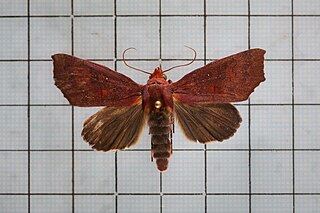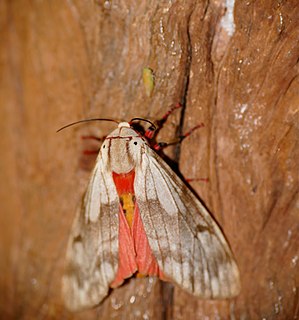Echeta is a genus of moths in the family Erebidae. The genus was erected by Gottlieb August Wilhelm Herrich-Schäffer in 1855.

Termessa nivosa is a moth of the subfamily Arctiinae first described by Francis Walker in 1865. It is found in the Australian states of New South Wales, South Australia and Victoria.

Virbia is a genus of tiger moths in the family Erebidae. The genus was erected by Francis Walker in 1854.
Dactyloplusia is a monotypic moth genus of the family Noctuidae erected by Chou Io and Lu Chinsheng in 1979. Its single species, Dactyloplusia impulsa, was first described by Francis Walker in 1865. It is found in Sri Lanka, India, southern China, Sundaland, Sulawesi, New Guinea, Fiji and Australia.
Manbuta is a genus of moths in the family Erebidae. The genus was erected by Francis Walker in 1865.

Antiblemma concinnula is a moth of the family Noctuidae first described by Francis Walker in 1865. It is found in Guadeloupe, Saint Kitts, Dominica, Grenada, Trinidad, Suriname and Brazil. It is also found in Florida.

Condica dolorosa is a moth of the family Noctuidae. It is found in the Indo-Australian tropics, including Borneo, Hawaii, Hong Kong, India, Sri Lanka, Taiwan and Queensland in Australia.

Chasmina candida is a moth of the family Noctuidae described by Francis Walker in 1865. It is found from Indo-Australian tropics east to Fiji, including many islands of the Indian Ocean and Pacific.

Anomis privata, the hibiscus-leaf caterpillar moth, is a moth of the family Erebidae. The species was first described by Francis Walker in 1865. It is found in China, Taiwan and Japan, but has also been recorded from North America, as most verified sightings have been in the northeastern United States.
Echeta juno is a moth of the family Erebidae. It was described by William Schaus in 1892. It is found in French Guiana and Brazil.
Echeta milesi is a moth of the family Erebidae. It was described by Walter Rothschild in 1922. It is found in Brazil.
Echeta minerva is a moth of the family Erebidae. It was described by William Schaus in 1915. It is found in Brazil.
Echeta pandiona is a moth of the family Erebidae. It was described by Caspar Stoll in 1782. It is found in Suriname.
Echeta rhodocyma is a moth of the family Erebidae. It was described by George Hampson in 1909. It is found in Peru.
Echeta trinotata is a moth of the family Erebidae. It was described by Reich in 1933. It is found in French Guiana, Brazil, Venezuela, Ecuador, Chile, and Bolivia.

Teracotona rhodophaea is a moth in the family Erebidae. It was described by Francis Walker in 1865. It is found in Botswana, Djibouti, Eritrea, Kenya, Namibia, Senegal, Somalia, South Africa, Tanzania, Togo, Zambia and Zimbabwe.
Colla micacea is a moth in the family Bombycidae. It was described by Francis Walker in 1865. It is found in Colombia and French Guiana.
Acantholipes trajecta is a species of moth in the family Erebidae first described by Francis Walker in 1865. It is found in South Africa, India, Sri Lanka, and Australia, where it has been recorded from Western Australia, the Northern Territory and Queensland.
Casama vilis is a moth of the family Erebidae first described by Francis Walker in 1865. It is found in Sri Lanka, India, Middle East, Ethiopia, Kenya and Somalia.
Lymantria detersa is a moth of the family Erebidae first described by Francis Walker in 1865. It is found in India.






